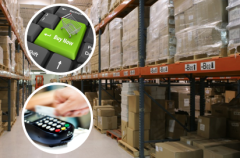As B2B and B2C eCommerce continues to increase in popularity, the line between wholesale, retail and eCommerce channels has started to blur. Wholesale companies, previously restricted to buying product from the manufacturer, storing in a warehouse and then selling and shipping to retail and distribution companies, are now starting to offer their product through other sales channels and to different consumers. With eCommerce sales expected to reach US $1.5 trillion by the end of this year, it’s no surprise that wholesale companies are interested in a piece of the eCommerce pie. Many wholesale companies have also branched into the retail space, by opening showrooms for their product, exhibiting at trade shows and building actual brick and mortar retail stores. In order to account for these new sales channels in an all-in-one system, it is important to look for proper inventory and accounting ERP software, with point of sale ("POS") functionality and eCommerce integration options. This way all data can be stored in a central database, and consequently, inventory levels and availability will be accurately reflected no matter which sales channel an order comes in from.
POS Functionality
Point of Sale features are designed to work instore with barcode readers, cash drawers, receipt printers and display poles to allow businesses to process debit, credit and cash sales. An ERP system with POS functionality will provide complete integration between store sales and back-end accounting and inventory. This allows for the integration of information such as GL, AR, commissions, and taxes, and means users can quickly look up inventory information in the system to determine whether product is available at a different location or currently on backorder. There is no need for double entry across multiple systems or accessing different systems for up-to-date account and inventory data. In addition, inventory and sales information can be tied together across several different retail locations, while still providing the option to report on each individual location’s specific sales and inventory numbers. This allows management to make decisions and assess opportunities at each different store location.
eCommerce Integration
When it comes to eCommerce integration for wholesale distribution companies, there are two distinct paths: sell through B2B eCommerce or B2C eCommerce (although some companies may choose to do both).
With B2C eCommerce, a website is set up that allows the end consumer to purchase products directly from the company or through third party websites such as Amazon or eBay. Depending on the sophistication of the eCommerce integration, order information can be automatically pulled from each website, into the back-end ERP system which then updates sales order and inventory information. Once the order is processed and shipped, shipping and tracking information is then pushed back up to the website for the consumer to see. Different levels of integration dictate how often this information is passed between systems and the level of automation in which it is done.
With B2B eCommerce, most sites are set up to act as a customer order portal, allowing customers to login with their unique login information to view product inventory information and place wholesale orders. Once logged in, they will be able to see inventory information in real-time, view product images, view past sales orders and get their specific pricing. After an order is placed online, this information is then automatically transferred back to your ERP system, similar to B2C integration - inventory gets automatically allocated, a sales order is created and then shipping information gets pushed back up after the order is processed.











